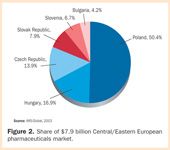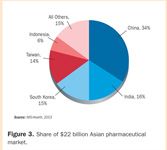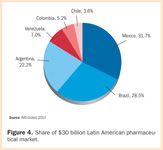Going Global
Applied Clinical Trials
Clinical trials in developing nations-called "ascending markets"-are exploding. These regions offer large naïve subject populations, low operating costs, and increasingly stable testing infrastructures, but regulatory reform is really driving the growth. CenterWatch data show 20%?30% of clinical trials are being conducted in ascending regions.
Clinical trials in developing nations-called "ascending markets"-are exploding. These regions offer large naïve subject populations, low operating costs, and increasingly stable testing infrastructures, but regulatory reform is really driving the growth. CenterWatch data show 20%–30% of clinical trials are being conducted in ascending regions.
The three major ascending regions are Eastern Europe, Latin America, and Asia. When considering trial placement, sponsors need to begin by asking two critical questions: Does the sponsor company itself have a local affiliate in the area? Can I be assured of performance quality? At issue is the need for assurance that the study will be started quickly, that the logistics of the study will run smoothly, and that overall, the study conduct activities will be managed as effectively as possible with high site quality.
Other selection criteria include the region's ethical review quality and regulatory restrictiveness. Notably, availability of study subjects is not a differentiating criterion among ascending markets, as abundant and treatment-naïve subject populations exist in all ascending regions (see Figure 1).

Figure 1. Population and output in ascending regions.
Eastern Europe
Sponsor companies are more likely to report consistent successes in Eastern Europe than in any of the other ascending markets studied.
The quality of Eastern European study sites rate the highest among the three major emerging geographic areas. Investigators are generally perceived to be a highly educated, well trained, and motivated group. Investigators in the region typically have a strong scientific background and are informed about advances in Western medicine, particularly those working in the Czech Republic, Hungary, and Poland. In a Thomson CenterWatch/iGATE Clinical Research International (iCRI) study designed to examine clinical research trends in ascending markets, respondents rated Eastern European study sites "excellent" in the critical categories of investigator experience, investigator disease knowledge, and GCP experience. Coordinator quality and efficiency of site operations both rate "good to excellent."
Language issues are a barrier in this region. English fluency at the site level can present difficulties. However, in light of the region's high marks in other key areas, language problems are more inconvenience than obstacle.
The major share of studies conducted in Eastern Europe is occurring in Bulgaria, Ukraine, the Czech Republic, Hungary, Poland, Romania, and Croatia. Thomson CenterWatch data show clinical trials growing most rapidly in Bulgaria, Estonia, the Czech Republic, Poland, and Hungary. Bulgaria leads the pack with 23% growth; Poland tops the list for most trials conducted with approximately 375 in 2001 (see Figure 2).

Figure 2. Share of $7.9 billion Central/Eastern European pharmaceuticals market.
Typically, trials conducted in Eastern Europe are in Phases II and III. Among the most common disease states studied in Eastern European trials are cardiovascular, oncology, diabetes, hypertension, respiratory, arthritis, and neurology.
Sponsors report that recruitment rates in Eastern Europe are five to ten times higher than in Western Europe and the United States-with no additional resources required to actively recruit patients. Eastern European patients are particularly attractive for studies in which long-term patient follow-up is desired because of the population's geographic stability.
Regulatory changes. Regulatory hurdles vary from country to country, with Russian regulations cited as by far the most difficult. "There is tremendous potential in Russia," notes a clinical development manager. "But...the customs regulations are horrendous." Local staff with expertise in the region and its systems and language is key throughout Eastern Europe. As one CRO commented, "The potential in Eastern Europe is tremendous, but you need people with local knowledge."
Outside of Russia, the regulatory outlook in Eastern Europe is promising. The Collaboration of Drug Regulatory Authorities in European Union Associated Countries (CADREAC), an association of EU countries, is revising drug laws to align Eastern Europe more closely with Western European regulations. As a result of this effort, 27 countries are expected to be fully aligned with European practices, including ICH-GCP standards. The implementation of the European Union Good Clinical Practices Directive (The Clinical Trials Directive 2001/20/EU) and the accession of some Eastern European countries, notably Poland, the Czech Republic, and Hungary, to EU membership should have a positive impact on the regulatory arena. The directive should bring these countries into line with the rest of the EU, but the short-term could be difficult.
Inconveniences can exist on at least two other fronts. Regulations require insurance forms to be tracked and filed appropriately, prompting some sites to hire insurance brokers to ensure that insurance paperwork is managed properly. Agreements and contracts can be another source of difficulty, perhaps resulting from translation problems.
Asia (excluding India)
In the spectrum of ascending markets, Asia poses the most challenging environment for clinical trials. Regulations in Asia are most restrictive overall among the three ascending regions. In China, difficulties can be acute; typical protocol approval timeframes in China range from nine to 18 months.
On overall GCP experience, the region earns a "poor to fair" mark. In terms of working with site personnel, Asian sites rate "fair to good" for investigator experience, investigator disease knowledge, and site operations efficiency. The majority of Asian countries do not have IRBs. Language problems can be substantial, with bilingual documentation common in China. As a general rule throughout Asia, a wide range in site quality necessitates careful site selection by sponsors. Sponsors point out, however, that in spite of many speed bumps, Asian trials do tend to progress quickly once approvals are in place.
Asian patients are least likely among their counterparts in other ascending regions to be familiar with Western medical practices and procedures. Still, the enormous drug-naïve population eager for quality medical care is not to be discounted. China, with a population of 1 billion, provides by far the largest population and the greatest number of trials in Asia, with Korea and Taiwan following. Other countries conducting trials include Thailand, Singapore, Malaysia, Vietnam, the Philippines, and Japan.
Southeast Asia shows distinct promise, in part because the region attracts a significant proportion of Western-trained, experienced investigators. Though small comparatively, Southeast Asian countries offer high-quality sites with a sizable pool of patients (see Figure 3).

Figure 3. Share of $22 billion Asian pharmaceutical market.
Studies in China are being conducted in Phases II through IV. The most common therapeutic areas studied in China include oncology, hepatitis B, cardiovascular, endocrine, and anti-inflammatory. Diabetes and metabolic diseases are common to developing countries and are increasingly being studied in Asia. Psychiatric studies are rarely conducted in Asia because mental disorders are generally not regarded as treatable illnesses.
Because each country has developed its own regulatory processes and systems for obtaining permits, sponsors conducting trials in Asia must be prepared to devote substantial resources to understanding the nuances of the distinct system in which they are operating. Additionally, patent protection laws remain a concern among sponsors. Progress has been made lately, but much remains to be done to put sponsors at ease.
Regulatory changes. A significant number of regulatory changes are underway in China. A set of new drug regulations were introduced in 2002, and in mid-2003 more changes were brought in by China's State Drug Administration. While some changes are intended to shorten approval timelines, many introduce obstacles into the approvals process.
On the positive side, Chinese drug policies are becoming more uniform. Changes have been introduced aimed at shrinking evaluation timelines to 100 working days. China has been favoring sponsors in recent court rulings, and offers market exclusivity to companies that conduct more studies in China. But many sponsor and CRO executives are clearly frustrated and disappointed with China's lack of substantial regulatory sophistication. A common refrain among sponsors and CROs is that China seems unable to get out of its own way. One CRO clinical development and operations senior director was perplexed by China's lack of progress:
"The regulatory part is an enigma to me. We thought that with the last release of regulations (last 12 to 15 months) that it would get better in China. We are disappointed with the amount of movement that they have made. When China was admitted into the World Trade Organization there were many meetings of government officials, pharma industry, and CRO representatives, but there was no significant movement. Progress is not nearly as fast as it needs to be."
A sponsor representative who had spent 10 years working in China said, "Like the FDA, you have to respect [the CSDA] and talk with them beforehand." A CRO decreased 12-to-18-month government approval timeframes to between nine and 11 months by collaborating with overtaxed government officials to get protocols approved.
In spite of the hurdles, Asia will remain front and center on sponsors' radar screens. Most major pharmaceutical companies are operating in China, supported by an assortment of CROs. Indicative of their commitment fulfilling the region's potential, sponsor and CROs are investing in training for Chinese investigators on GCP-an effort that is showing real results in boosting site quality.
India: an emerging market
With an enormous drug-naïve subject population, widespread English fluency, a sophisticated technological infrastructure and regulations increasingly aligned with those in the West, India is widely regarded as having substantial potential for clinical studies in a wide range of therapeutic areas. Nearly all major pharmaceutical companies have put down roots in Indian soil. CROs, too, are flocking to India with more than 15 ramping up operations.
Within the areas of investigator experience, coordinator quality, and site operations efficiency, India rates nearly as impressively as Eastern Europe. India exceeds all emerging regions in providing fluent English speakers.
The country lags notably in GCP experience, however. One clinical research director at a medical college working to build a clinical trials operation "from the ground up" notes that significant resources must be devoted to ICH-GCP training with each new trial. Another director notes that sponsors must be willing to invest in training. Investment at the site level is on the short list of major determinants of study success.
Trials are being conducted in Phases II through IV across a range of disciplines. The majority of India-based trials focus on psychiatry, oncology, infectious disease, cardiovascular, and endocrinology. Tropical diseases are more common in India's climate. In the country's more affluent urban centers, however, "Western" diseases like diabetes and heart disease are increasingly prevalent.
While India offers a sizable naïve subject population, its demographics are changing. Awareness of subject consent issues and information about trials is becoming more prevalent in India and in individuals' decisions about study participation. The influence of patient advocacy groups seems to vary according to region, or perhaps from medical center to medical center; some investigators report seeing the groups quite frequently, others say there are "hardly any" in India. On the positive side, Indian patients today are more likely to trust physicians than they were a decade ago.
Regulatory changes. India's regulatory community is demonstrating to sponsors that the country is serious about becoming a major destination for clinical trials. Sweeping changes are promoting, in one executive's words, a "clinical research culture" in India. For each barrier to sponsor acceptance-lack of patent protection, insufficient GCP compliance-India has responded with meaningful and relatively swift regulatory adjustments. The recent overhaul of India's patent laws is indicative of this dedication to meeting sponsor needs. While India has historically offered no patent protection, major patent law changes will come into effect in 2005. Regulatory changes are also underway to promote much-needed GCP training. Other recent changes strike at the core of sponsor concerns about conducting trials in the region: removal of the country's import duty, freeing of restrictions on simultaneous global clinical trials, and speeding of study start-up times.
To address lengthy study approval times, India's Drug Controller General, a division of the Ministry of Health, is streamlining its trial approval process. (The DCG is responsible for formally approving each trial conducted in India as well as other oversight issues.) The Indian government is promoting GCP through new guidelines issued by the India Council of Medical Research. The ICMR has revved up ICH-GCP training for IRBs, described by one CRO president as a "training spree." Further, the Forum for Ethics Review Committees in India is bolstering ethics committee training, filling a critical gap in ethical awareness.
What effect these new changes will have on clinical trials remains to be seen. Though sponsors may feel impatient for change, the long view shows India's progress is substantial. One CEO of a clinical trials company notes that changes in India have been impressive since his company began in 1994. At that time there were few ethics review boards, and patient consent was completely foreign to Indians. "The law is changing now," he said. "It is going to happen in the next few months. India will be able to conduct trials on par with the rest of the world."
Latin America
Latin America has the most ground to make up in order to become an attractive ascending market. Better, faster investigator training is critical in Latin America. Compounding the quality issue are language problems. Many site workers do not speak sufficient English to complete CRFs. Sponsors find they must hire translators. "There is constant translation of documents-both in terms of official submissions to IRBs plus the regular, day-to-day communication," said one sponsor. "We have to act as a bridge with communication."
A critical need for jobs and the attractiveness of site employment may ultimately solve these problems. "Clinical research is being taken seriously in Latin America," observes one sponsor. "There is a high rate of unemployed people and it is good for people to get into the clinical research business." Sites that leverage the ample labor supply by providing critical training and, in some cases, introducing translators to the study process, have a distinct advantage. Some sponsors caution, though, that operating in Latin America is not as cheap as it may seem. Savings in subject recruitment can be easily gobbled up by importing/exporting fees and other costs.
Argentina, Mexico, and Brazil provide the region's major markets (see Figure 4). Smaller Latin American countries with relatively stable sociopolitical climates have been very successful as well. Costa Rica, Chile, and Peru offer investigators eager for work and study approval processes that are simple and fast.

Figure 4. Share of $30 billion Latin American pharmaceutical market.
Most research conducted in Latin American countries comprises Phases III and IV, with Phase II studies increasing. Common disease states studied include infectious disease, oncology, rheumatology, dermatology, cardiovascular, and CNS. Panama in particular has shown expertise in conducting oncology and infections disease trials, as well as with AIDS and dermatology studies.
Sociopolitical issues. Sociopolitical issues come with the territory in Latin America. How they affect trials can vary. An executive at an international CRO said, "There is instability in the [Latin American sociopolitical] system, so you need to have a contingency plan when you operate in the region." Argentina, the region's largest market, recently saw upheaval in its government. A recent shift of political power in Brazil rippled to the Ministry of Health, resulting in additional delays in the already difficult approval process. Sponsors are facing indefinite delays in Venezuela while the country grapples with widespread social and political unrest. Colombia offers substantial opportunity with a large population and high-quality sites and facilities, but political conflict is causing sponsors to be wary of making plans there.
Regulatory issues. Approval times can range from four to six months in Latin America. Argentina, widely considered most advanced among its neighbors in terms of regulations, nonetheless requires sites to seek approval through a cumbersome, multistep process. Argentina also rates poorly for its insufficient patent protections.
Brazil, Latin America's largest and most populous country and the region's leading economic power, poses the most problematic regulatory environment in Latin America. Customs laws in Brazil are complex, and importing/exporting is costly. Additionally, Brazilian ethics committees can be highly restrictive.
In contrast, tiny Costa Rica provides the most advanced environment in Latin America for clinical trials, and is home to the largest private facility dedicated to clinical studies, the Costa Rican Institute for Clinical Investigation (ICIC). Costa Rica is stable politically, has a relatively high standard of living, is small in area (smaller than West Virginia), and is home to 3 million people.1 A recent law placed more restrictions on conducting clinical studies in Costa Rica, however, and the country's IRB approval process has since become stricter.
A local staff person is considered one key success factor in negotiating Latin American countries' bureaucratic twists and turns. As one sponsor commented: "The main reasons why clinical trials fail are lack of local knowledge and lack of understanding of the customs of the country...You need to have a local person in each country."
Latin America holds a great deal of potential for the clinical trials industry, but regulatory reform will have to be instituted in order to bring it in line with other ascending markets.
Looking ahead
Each of these ascending markets shows unique promise for sponsors seeking large naïve subject populations and adequate to excellent site quality. Eastern European sites are ahead of the game in terms of overall competency and India is quickly gaining ground. The paths of Latin American and Asian trials are less clear. However, growth in each market is significant and will continue.
Regulatory hurdles and local bureaucracies will continue to challenge sponsors and the sites with which they partner. Where possible, sponsors should seek to influence regulatory and legislative changes advantageous to clinical trials, particularly those that encourage ICH-GCP compliance, shortened protocol approval times, and improved patent protections. Meanwhile, management in ascending regions should concentrate on understanding how to best negotiate local bureaucracies through better collaboration with authorities, and on contracting with local, native workers who can facilitate communications.
Sponsors should also realize they are bringing significant economic advantages to ascending regions. Training workers in critical investigative skills can result in higher site quality and a more stable clinical trials infrastructure. This is especially true in Latin America.
Finally, sponsors should bear in mind that they are not alone in their impatience to westernize developing countries' business cultures. Executives should keep an eye fixed on the future, realizing the inconveniences of today are the cost of doing business in an area where opportunity is unprecedented.
Data for this article were collected through 21 in-depth interviews with individuals from biopharmaceutical companies, CROs, regulatory agencies, and health ministries. The individuals interviewed had expertise in conducting trials in Eastern Europe, Latin America, and Asia (including India). Thomson CenterWatch worked in collaboration with iGATE Clinical Research International (iCRI).
References
1. The World Book Fact Book,
http://www.cia.gov/cia/publications/factbook/geos/cs.html
.
Mary Jo Lamberti,* PhD, is senior manager, market intelligence, with Thomson CenterWatch, 22 Thomson Place 47F1, Boston, MA 02210, 617-856-5956, fax 617-856-5901, email: maryjo.lamberti@thomson.com. Susanna Space is a writer and Sara Gambrill is senior writer with Thomson CenterWatch.
*To whom correspondence should be addressed.
Improving Relationships and Diversifying the Site Selection Process
April 17th 2025In this episode of the Applied Clinical Trials Podcast, Liz Beatty, co-founder and chief strategy officer, Inato, discusses a number of topics around site engagement including community-based sites, the role of technology in improving site/sponsor relationships, how increased operational costs are impacting the industry, and more.
Behind the Buzz: Why Clinical Research Leaders Flock to SCOPE Summit
February 7th 2025In this episode, we meet with Micah Lieberman, Executive Conference Director for SCOPE Summit (Summit for Clinical Ops Executives) at Cambridge Innovation Institute. We will dive deep into the critical role of collaboration within the clinical research ecosystem. How do we bring together diverse stakeholders—sponsors, CROs, clinical trial tech innovators, suppliers, patients, sites, advocacy organizations, investors, and non-profits—to share best practices in trial design, program planning, innovation, and clinical operations? We’ll explore why it’s vital for thought leaders to step beyond their own organizations and learn from others, exchanging ideas that drive advancements in clinical research. Additionally, we’ll discuss the pivotal role of scientific conferences like SCOPE Summit in fostering these essential connections and collaborations, helping shape the future of clinical trials. Join us as we uncover how collective wisdom and cross-industry partnerships are transforming the landscape of clinical research.
